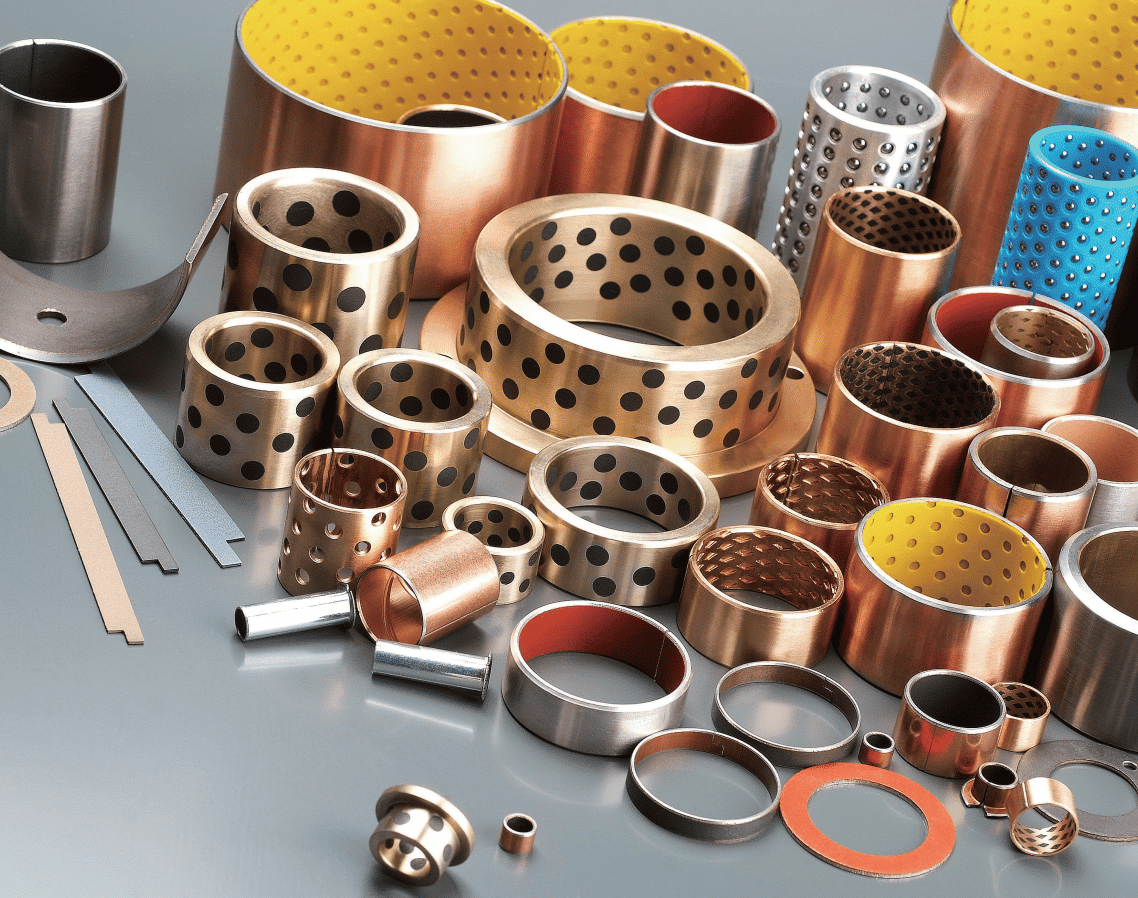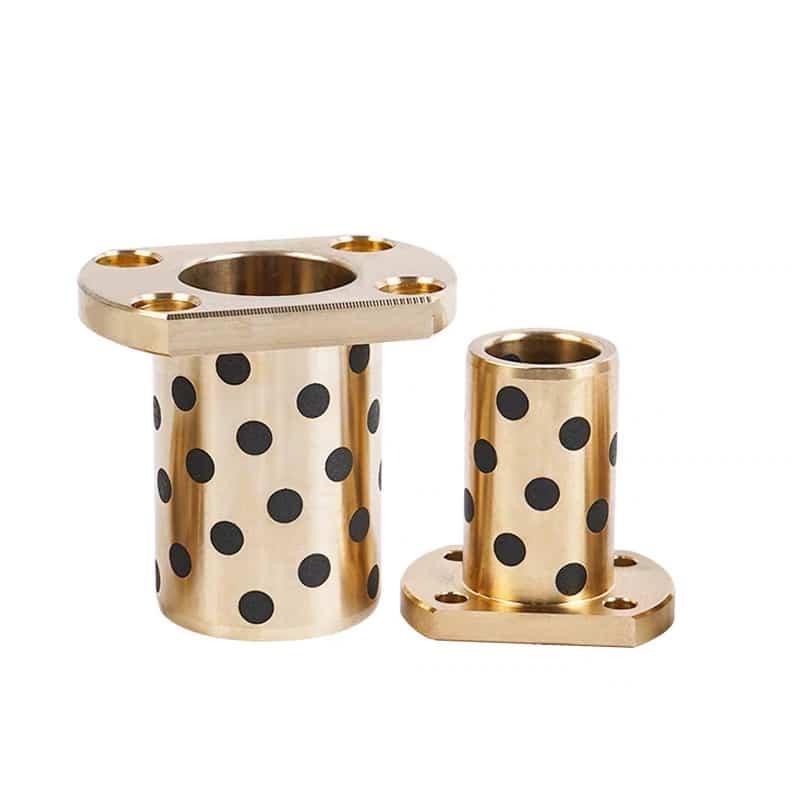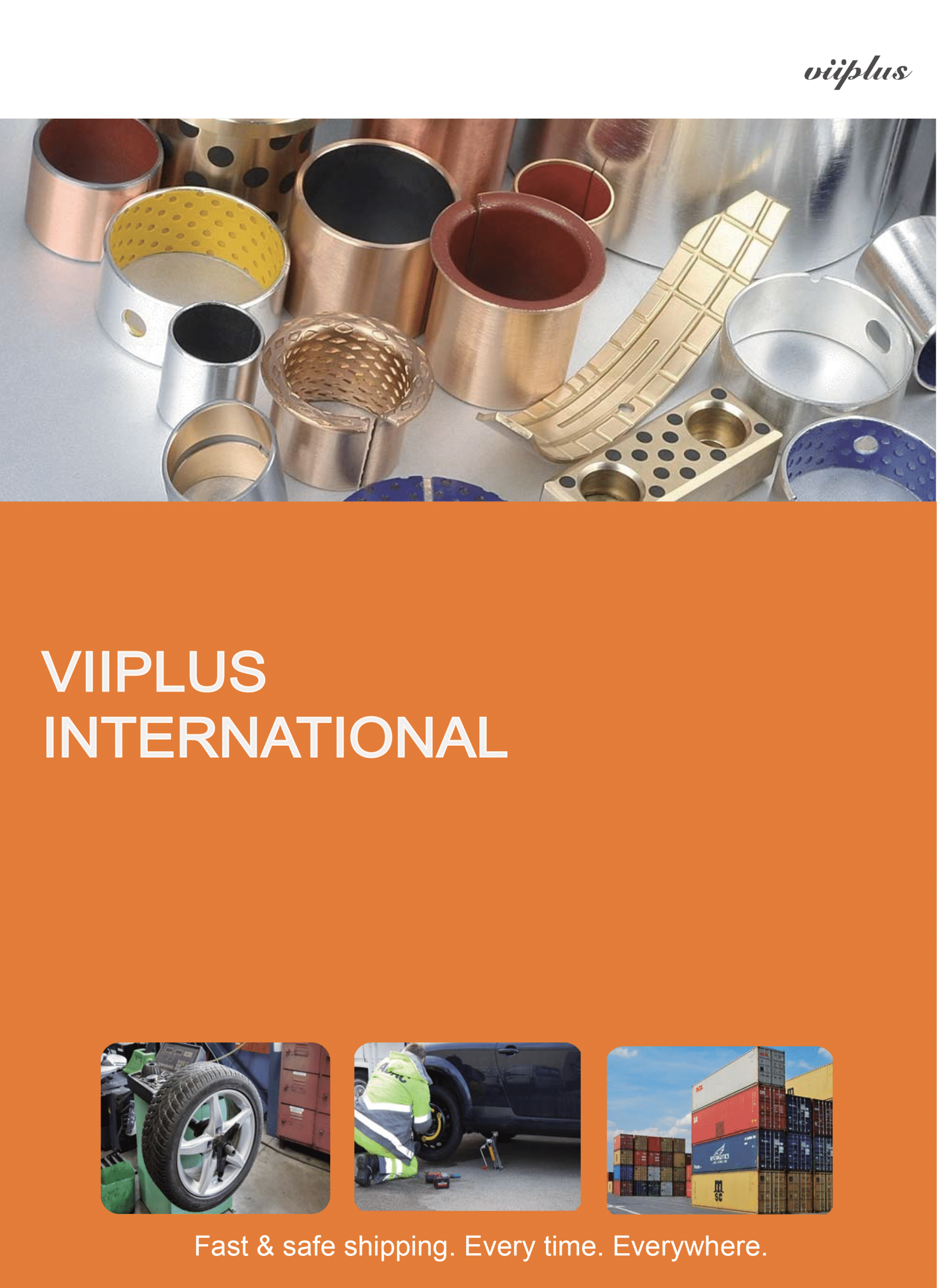What Makes Graphite A Superior Lubricant?
Bearings and Bushings for the Future: Precision and Customization: Our company, in bearing engineering with decades of experience, designs and develops high-precision self-lubricating bronze bearings & plain bushes. We offer a wide array of sliding bearings tailored to meet specific needs. Renowned for our expertise in custom bronze bushing and slide plate solutions, we provide an expansive selection of bushing metal alloys. Contact us today to benefit from unparalleled services at competitive prices.
What Makes Graphite A Superior Lubricant?
What Makes Graphite A Superior Lubricant?
Graphite is a popular lubricant for various applications due to its superior characteristics. Graphite bushings can be customized to meet your specific needs.
Experience
Replacing a plastic bushing with bronze? Bronze bushings are more resistant to deformation and fracture than other materials.
Bearing Solutions
Components are self-lubricating, Bushing vs. Bearing: What is Best for Your Application?
Online Support
Selecting Bearings or Bushings for your industry!
Make Graphite A Superior Lubricant, Manufacturer of Precision Mold and Die Components
Custom Graphite Bushing: A Self-Lubricating Material: What Makes Graphite a Superior Lubricant? Graphite functions as a self-lubricating material, eliminating the need for additional lubrication, which can actually hinder its performance. Liquid lubricants attract dirt and grit, leading to premature wear on graphite.
As a versatile lubricant, graphite excels in various environments due to its low friction coefficient, chemical stability, and resistance to shearing forces, making it ideal for high-temperature, high-pressure, and chemically aggressive conditions. Environmentally friendly and durable, graphite is a cost-effective solution, maintaining its popularity across diverse industries.
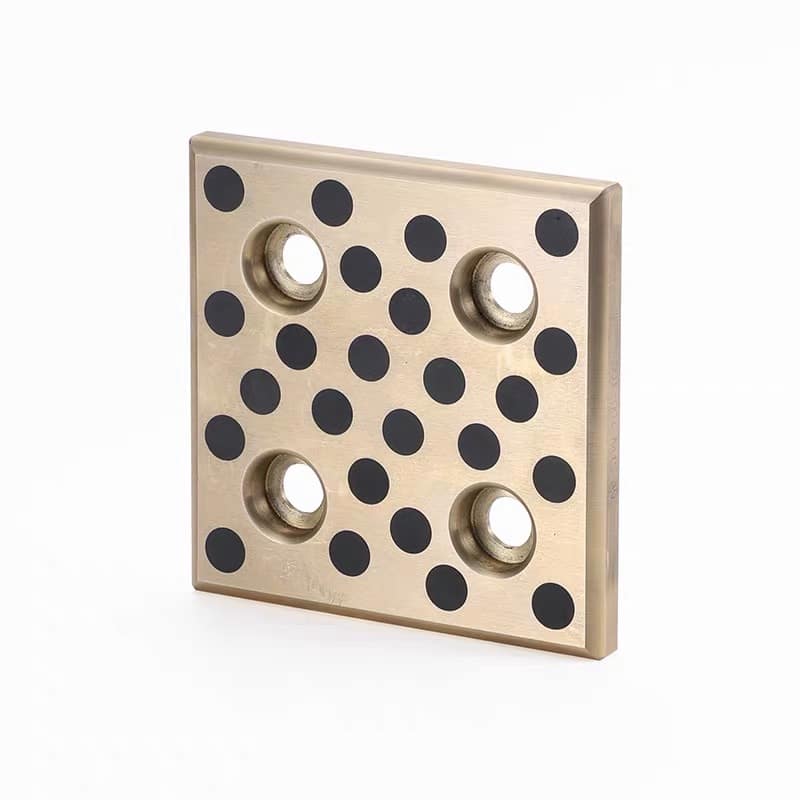
Components are self-lubricating graphite plate
Self-lubricating graphite plates are frequently used in bearings, seals, and thrust washers, offering effective, long-lasting lubrication without the need for additional lubricants. They are especially valuable in high-temperature or vacuum environments where conventional lubricants are impractical or maintenance is challenging.
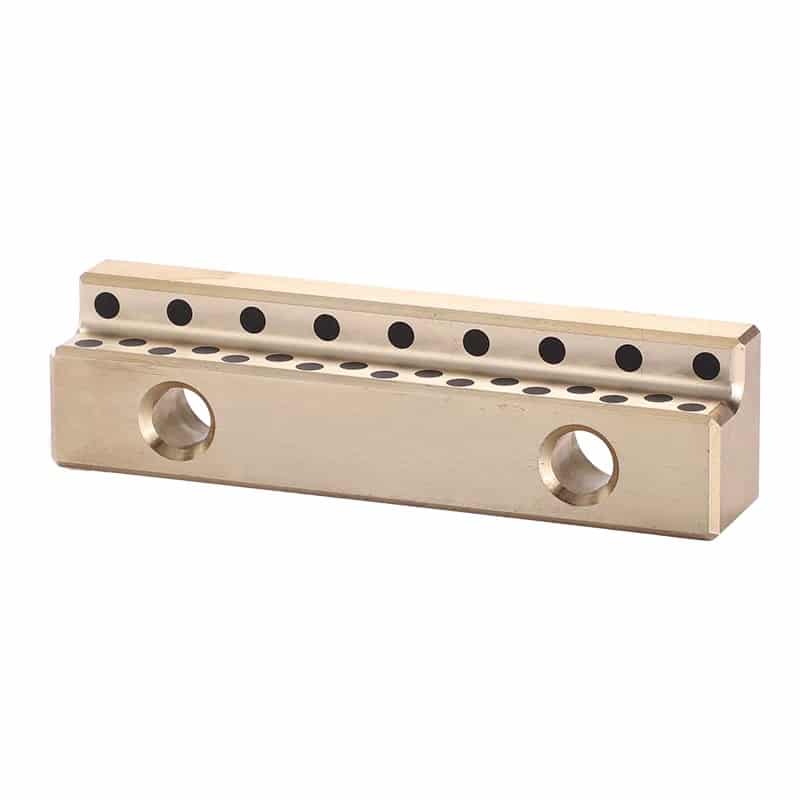
Self-lubricating High-Temperature Graphite Plate Material
Self-lubricating graphite plates are made of a graphite matrix infused with lubricants like oil or resin. This lubricant saturates the graphite’s pores, ensuring a consistent lubrication supply that minimizes friction and wear. Additionally, the graphite matrix offers advantages such as high-temperature resistance, chemical inertness, and good electrical conductivity.
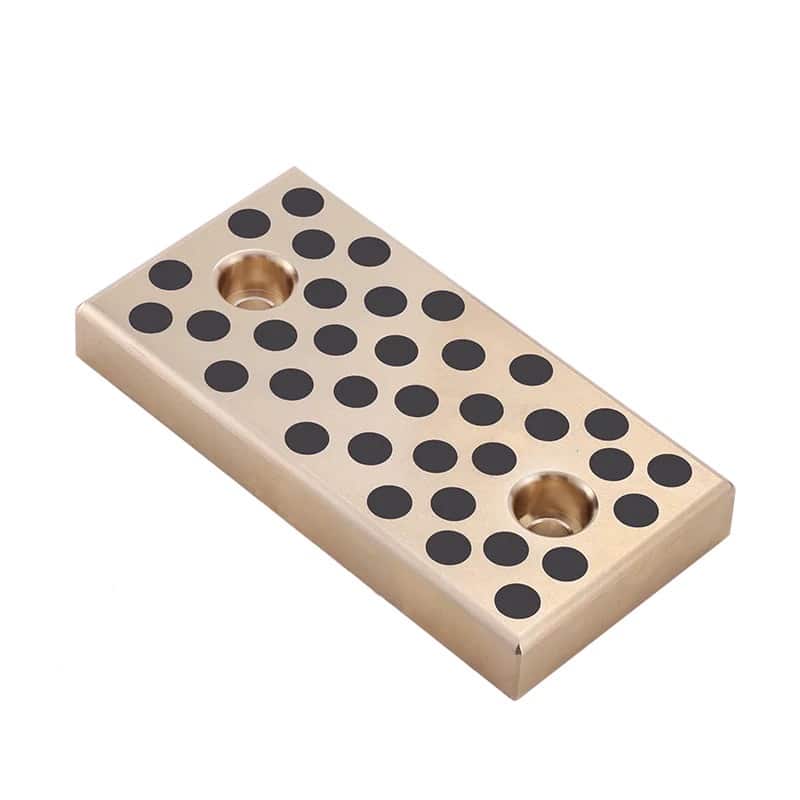
Self-lubricating graphite plates. Order Now!
Self-lubricating graphite plates may use either solid or liquid lubricants, depending on the application. Solid lubricants, like molybdenum disulfide, are preferred for high-temperature scenarios due to their stability under extreme conditions. In contrast, liquid lubricants such as oil or resin are typically used in applications requiring frequent replenishment or low friction.
Graphite Lubrication: The Slippery Secret Behind High-Performance Bearings & Bushings
Friction and wear are the persistent enemies of mechanical systems. In the relentless battle against them, engineers deploy a variety of lubricants. While oils and greases are commonplace, solid lubricants offer unique advantages, especially in demanding environments. Among these, graphite stands out as a versatile and effective solution, particularly for bearings and bushings.
But what exactly is graphite, and how does it work its magic? Why choose it over other options like MoS₂? What are self-lubricating bearings, and what do terms like SL1 and SL2 signify?
This post dives deep into the world of graphite lubrication, moving beyond the surface to give you a clearer understanding of its properties, applications, and comparisons.
What is Graphite? More Than Just Pencil Lead
Graphite is one of the most common allotropes (different structural forms) of pure carbon, alongside diamond and graphene. Unlike diamond’s rigid tetrahedral structure, graphite features a layered, hexagonal lattice structure.
Imagine incredibly thin sheets (graphene layers) stacked like a deck of cards.
-
Within each layer: Carbon atoms are strongly bonded (covalent bonds), making the layers themselves very strong and stable.
-
Between the layers: The bonds are much weaker (van der Waals forces).
This unique layered structure is the key to graphite’s lubricity. When shear force is applied (like two surfaces moving against each other), these weak inter-layer bonds allow the sheets to easily slide over one another, providing a low-friction interface.
Key Properties of Graphite Relevant to Lubrication:
-
Excellent Thermal Stability: Performs well at very high temperatures (up to ~450°C / 842°F in air, and much higher in inert/vacuum environments where oxidation isn’t a concern).
-
Chemical Inertness: Resists attack from many chemicals and corrosive environments.
-
Good Electrical & Thermal Conductivity: Useful in applications where static discharge or heat dissipation is needed.
-
Low Coefficient of Friction (CoF): Especially effective under boundary lubrication conditions.
An Important Note on Moisture: Historically, it was believed graphite required adsorbed moisture or gases between its layers to be an effective lubricant in air. While adsorbed molecules do help lower friction in atmospheric conditions by further weakening inter-layer forces, modern understanding shows graphite can lubricate effectively in dry environments and even vacuum, although its friction coefficient might be slightly higher under such conditions compared to optimal humidity levels.
How Graphite Works as a Solid Lubricant
When used as a lubricant between moving surfaces (like a shaft rotating within a bushing):
-
Adhesion & Film Formation: Fine graphite particles adhere to the mating surfaces.
-
Shearing: As the surfaces move, the graphite layers slide easily over each other at the weak van der Waals planes.
-
Transfer Film: A thin, durable film of oriented graphite particles forms on the surfaces, creating a solid layer that prevents direct metal-to-metal contact and reduces friction and wear.
This mechanism makes graphite ideal for:
-
High-Temperature Applications: Where oils and greases would burn off or decompose.
-
Vacuum Environments: Where liquid lubricants would evaporate.
-
Applications Requiring Cleanliness: No dripping or spattering like oils/greases.
-
Preventing Seizure: Especially during run-in periods or under heavy loads.
Self-Lubricating Bearings: Maintenance-Free Motion
One of the most powerful applications of graphite is in self-lubricating bearings and bushings. These components are designed to operate without the need for external lubrication (oils or greases) throughout their service life.
How is this achieved?
The graphite (or another solid lubricant) is integrated directly into the bearing material matrix. Common types include:
-
Metal-Matrix Composites (e.g., Bronze-Graphite): Powdered bronze and graphite are mixed, compacted, and sintered (heated to bond particles). The bronze provides structural strength and heat dissipation, while the graphite particles, distributed throughout the matrix, migrate to the surface during operation to provide continuous lubrication. These are often porous, sometimes allowing for initial oil impregnation (like SAE 841) which works synergistically with the graphite.
-
Polymer-Matrix Composites (e.g., PTFE/PEEK + Graphite): Engineering polymers like PTFE, PEEK, Nylon, or Acetal are compounded with graphite fillers. The polymer provides the matrix, chemical resistance, and low friction characteristics, while graphite enhances wear resistance, thermal conductivity, and sometimes reduces the friction coefficient further.
-
Carbon-Graphite Bearings: These are primarily composed of carbon and graphite, baked at high temperatures. They offer excellent thermal stability, chemical inertness, and self-lubricating properties, making them suitable for extreme temperatures and corrosive environments (e.g., pumps, ovens).
Benefits of Graphite-Based Self-Lubricating Bearings:
-
Reduced/Eliminated Maintenance: No need for regreasing schedules.
-
Clean Operation: Ideal for food processing, textiles, or sensitive environments.
-
Wide Temperature Range: Operates where liquid lubricants fail.
-
Cost-Effective Lifecycle: Lower maintenance costs offset potentially higher initial component cost.
-
Tolerance for Neglect: Continues to function even if maintenance is overlooked.
Comparing Solid Lubricants: Graphite vs. MoS₂ vs. PTFE
Graphite isn’t the only player in the solid lubricant game. Molybdenum Disulfide (MoS₂) and Polytetrafluoroethylene (PTFE) are also common. Choosing the right one depends heavily on the application specifics.
| Feature | Graphite | Molybdenum Disulfide (MoS₂) | PTFE |
| Structure | Layered Hexagonal Carbon | Layered Hexagonal Mo & S | Long Polymer Chains |
| Lubrication Mechanism | Easy shearing between layers | Easy shearing between S-Mo-S layers | Low intermolecular forces, smooth surface |
| Typical CoF (Dry) | 0.08 – 0.15 (can vary) | 0.03 – 0.08 (Often lower than Graphite) | ~0.04 (Lowest static CoF) |
| Max Temp (Air) | ~450°C (842°F) – Oxidizes | ~350°C (662°F) – Oxidizes | ~260°C (500°F) – Decomposes |
| Max Temp (Inert/Vac) | Very High (>2000°C / 3632°F) | Moderate (~1100°C / 2012°F) | ~260°C (500°F) |
| Load Capacity | Good | Excellent (Higher than Graphite) | Low to Moderate (Prone to creep) |
| Vacuum Performance | Good (CoF may increase slightly) | Excellent (Preferred for vacuum) | Good (Low outgassing) |
| Moisture Effect | Reduces CoF in air; not required | Increases CoF/Corrosion (Avoid Humidity) | Generally unaffected |
| Electrical Conduct. | Good | Semiconductor/Insulator | Excellent Insulator |
| Primary Applications | High Temps, Self-Lube Bearings, Brushes, Seals | High Loads, Vacuum, Metal Forming | Low Friction Liners, Seals, Chemical Resist. |
Key Contrasts:
-
MoS₂ vs. Graphite: MoS₂ generally offers lower friction and higher load capacity but is sensitive to moisture (which increases friction and can cause corrosion) and oxidizes at lower temperatures in air. MoS₂ is often preferred for vacuum applications.
-
PTFE vs. Graphite: PTFE boasts extremely low static friction but has poor load-carrying capacity (it can cold-flow or “creep” under load) and a much lower temperature limit. Graphite is better for higher loads and temperatures.
Additives and Formulations: What About SL1, SL2, etc.?
Often, you’ll encounter graphite lubricants or bearings specified with codes like “SL1,” “SL2,” or other proprietary designations.
-
These are NOT standardized types of graphite itself.
-
They typically represent specific formulations developed by manufacturers.
These formulations might involve:
-
Specific Graphite Grades: Varying particle size, purity, or morphology tailored for performance.
-
Binders: Resins or other materials used to hold the graphite together or help it adhere to surfaces, especially in coatings or composite materials.
-
Other Additives:
-
MoS₂: Sometimes blended with graphite to combine MoS₂’s high load capacity with graphite’s thermal stability or moisture tolerance.
-
PTFE: Added to graphite composites for further friction reduction in certain conditions.
-
Metal Powders (Copper, Bronze, Antimony): Added to carbon-graphite or metal-matrix bearings to improve strength, thermal conductivity, or wear resistance.
-
Ceramics: Added for extreme wear resistance.
-
SL1, SL2 (and similar codes) usually indicate:
-
A specific Self-Lubricating bearing material grade from a manufacturer.
-
The “1” and “2” might denote different compositions, performance levels (e.g., load capacity, temperature range), or intended applications defined by that manufacturer.
Crucially: Always refer to the manufacturer’s datasheet for materials designated SL1, SL2, etc. The datasheet will specify the composition (often generally, e.g., “Bronze-Graphite Composite”), performance characteristics (PV rating, temperature limits, CoF), and recommended applications.
Choosing the Right Graphite Lubrication Solution
Selecting the best graphite-based lubricant or bearing involves considering:
-
Operating Temperature: Is it consistently high? Graphite excels here.
-
Load & Speed (PV Value): Will the bearing see high pressure (P) and velocity (V)? Check the material’s PV rating. MoS₂ or specific metal-graphite composites might be needed for extreme loads.
-
Environment: Is moisture present? Is it a vacuum? Is chemical exposure a concern? Graphite is robust, but MoS₂ is better for vacuum, while polymers offer chemical resistance.
-
Form Factor: Do you need a powder, a grease additive, a spray coating, or a solid self-lubricating bearing?
-
Cost vs. Performance: While self-lubricating bearings can have a higher initial cost, they often save significantly on maintenance and downtime.
Conclusion: Graphite’s Enduring Role in Lubrication
Graphite is far more than just pencil lead; it’s a high-performance solid lubricant crucial for reliable operation in demanding applications. Its unique layered structure provides inherent lubricity, excellent thermal stability, and chemical resistance.
When incorporated into self-lubricating bearings (whether metal, polymer, or carbon-based), graphite enables maintenance-free operation in environments where traditional lubricants fail. While alternatives like MoS₂ and PTFE have their own strengths, graphite holds a vital place, particularly for high-temperature and robust self-lubricating solutions. Understanding its properties, how it compares to other lubricants, and the nature of proprietary formulations like SL1/SL2 empowers engineers and maintenance professionals to make informed choices for optimal system performance and longevity.
Custom Graphite Bushings: Leveraging a Superior Self-Lubricating Material
Custom graphite bushings offer exceptional performance due to graphite’s inherent self-lubricating properties. Understanding what makes graphite a superior lubricant is key to appreciating the value of these components.
Why Graphite Excels as a Lubricant:
Graphite’s effectiveness stems from a unique combination of characteristics:
-
Low Coefficient of Friction: Graphite’s layered (laminar) structure allows its planes to slide easily against each other and other surfaces. This minimizes resistance, reducing wear, tear, and heat generation. This property is crucial in high-temperature and high-pressure scenarios where conventional liquid lubricants might fail or evaporate.
-
Chemical Stability: Graphite is remarkably inert, resisting reactions with most acids, bases, and other chemicals. This makes it ideal for lubrication in harsh chemical environments without corroding or degrading, ensuring long-term reliability.
-
Resistance to Shearing Forces: The same laminar structure that provides low friction also allows graphite to withstand significant shearing forces. This makes it highly effective in applications involving sliding or rolling motions, particularly under high loads or at high speeds, as it minimizes surface wear.
Performance in Demanding Environments:
These properties enable graphite lubricants and bushings to thrive in challenging conditions:
-
High Temperatures: Used in steel mills and other hot environments where oils break down.
-
High Pressures: Effective in hydraulic systems and high-load bearings, reducing friction and heat.
-
Harsh Chemical Environments: Ideal for chemical and petrochemical industries due to its non-reactive nature.
Advantages Over Conventional Lubricants:
Compared to traditional oil or grease-based lubricants, graphite offers:
-
Wider Temperature Range: Effective at temperatures far exceeding the limits of many oils.
-
Chemical Inertness: Won’t react with process materials or degrade in corrosive settings.
-
Dry Lubrication: Provides lubrication without liquid contamination or mess.
-
Longevity & Reduced Maintenance: Its durability and self-lubricating nature often lead to longer component life and less frequent maintenance, contributing to a lower total cost of ownership.
Conclusion:
Graphite’s low friction, chemical stability, and resistance to shear make it an outstanding lubricant. Custom graphite bushings harness these qualities, providing reliable, long-lasting, and maintenance-friendly solutions for demanding industrial applications across various environments.
Option 2 (Slightly More Detailed, Flowing Narrative):
The Power of Self-Lubrication: Why Custom Graphite Bushings Excel
Custom graphite bushings are sought-after components in many industries, primarily because they are made from graphite – a naturally superior self-lubricating material. Let’s explore the characteristics that give graphite its remarkable lubricating capabilities.
Graphite’s Core Lubricating Strengths:
Graphite’s unique atomic structure is the foundation of its lubricating prowess. It exhibits three key characteristics:
-
Exceptional Low Friction: Graphite possesses a naturally low coefficient of friction. Its internal structure consists of layers (lamellae) that can slide past one another with minimal resistance. When used as a lubricant or bushing material, this translates directly to reduced friction between moving parts, minimizing wear and preventing excessive heat buildup. This makes it invaluable in high-temperature and high-pressure applications where traditional lubricants often decompose or become ineffective.
-
Robust Chemical Stability: A significant advantage of graphite is its chemical inertness. It does not readily react with most chemicals, including strong acids and bases, nor does it corrode. This stability allows graphite bushings and lubricants to perform reliably over long periods, even in aggressive chemical processing environments where other materials would quickly fail.
-
High Shear Strength: The layered structure of graphite also imparts excellent resistance to shearing forces. This means it can withstand the stresses generated by sliding or rolling contact, even under substantial loads or at high speeds, without breaking down. This resilience protects the surfaces in contact, extending the operational life of machinery.
Versatility Across Operating Conditions:
Thanks to these properties, graphite demonstrates reliable performance across a wide spectrum of demanding environments:
-
It excels in high-temperature settings, such as lubricating rollers in steel mills, where extreme heat is commonplace.
-
It performs reliably under high pressure, like within hydraulic systems, maintaining low friction and preventing wear between components.
-
Its chemical stability makes it a go-to lubricant in the chemical and petrochemical industries, where exposure to reactive substances is frequent.
Graphite vs. Conventional Lubricants:
When compared to conventional oil and grease lubricants, graphite offers compelling advantages:
-
Temperature Resilience: Operates effectively at temperatures that cause oils to break down or evaporate.
-
Chemical Compatibility: Safe for use in environments where chemical reactions are a concern.
-
Clean, Dry Operation: Provides lubrication without the potential contamination associated with wet lubricants.
-
Durability and Cost-Effectiveness: Its inherent toughness and self-lubricating nature reduce wear and the need for frequent reapplication or component replacement, often leading to a lower overall lifecycle cost.
In essence, graphite’s unique blend of low friction, chemical inertness, and shear resistance makes it a premier material for lubrication challenges. Custom graphite bushings leverage these benefits to deliver dependable, long-lasting performance tailored to specific industrial needs.
Choose the option that best fits the context and desired level of detail for your audience. Both versions aim to be clearer, more organized, and less repetitive than the original text.
let’s break down the specific characteristics that make graphite a superior lubricant, particularly in certain situations:
-
Unique Atomic Structure (The Core Reason):
-
Layered Lattice: Graphite consists of stacked layers of carbon atoms arranged in a hexagonal pattern (like graphene sheets).
-
Strong Intra-layer Bonds: Within each layer, the carbon atoms are very strongly bonded (covalent bonds), making the layers themselves robust and stable.
-
Weak Inter-layer Bonds: Crucially, the forces holding these layers together (van der Waals forces) are very weak.
-
Easy Shear: This combination means the layers can slide over each other with very little force, like shuffling a deck of cards. When placed between moving surfaces, these layers shear easily, providing a low-friction interface. This is the fundamental mechanism of its lubricity.
-
-
High Thermal Stability:
-
Performance at Extreme Temperatures: Graphite can withstand very high temperatures (up to ~450°C / 842°F in air, and much higher in inert or vacuum environments) without breaking down, burning off, or losing its lubricating properties. This makes it vastly superior to conventional oils and greases in high-temperature applications like ovens, kilns, foundries, and certain engine components.
-
-
Chemical Inertness:
-
Resistance to Corrosion and Attack: Graphite is largely unaffected by most acids, alkalis, and solvents. This allows it to lubricate effectively in chemically aggressive environments where other lubricants would degrade or react with the surrounding materials.
-
-
Effective Film Formation:
-
Adhesion and Transfer: Graphite particles readily adhere to metal and other surfaces. During operation, they form a durable, solid “transfer film” on the mating components. This film provides a continuous low-friction barrier, preventing direct metal-to-metal contact and significantly reducing wear.
-
-
Solid Lubricant Advantages:
-
No Dripping or Splatter: Being a solid, it stays where it’s put. This is critical in applications requiring cleanliness (food processing, textiles, electronics) or where contamination from migrating liquid lubricants is unacceptable.
-
Vacuum Performance: Unlike liquids that evaporate, graphite functions well in vacuum environments (though MoS₂ is often preferred for ultra-high vacuum due to outgassing concerns and lower friction in vacuum).
-
Long-Lasting / Self-Lubrication: When embedded into materials (like bronze or polymers) to create self-lubricating bearings, it provides continuous lubrication for the life of the part without needing replenishment, drastically reducing maintenance.
-
-
Good Load-Carrying Capacity: While perhaps not as high as MoS₂, graphite generally offers good performance under moderate to heavy loads, especially when formulated correctly in composites or greases.
In essence, graphite is superior when:
-
High temperatures would destroy liquid lubricants.
-
Chemical resistance is required.
-
Cleanliness is paramount (no dripping).
-
Maintenance-free, long-life lubrication is needed (self-lubricating parts).
-
Electrical conductivity through the lubricant is acceptable or desired.
It’s not universally superior (e.g., MoS₂ often has lower friction in vacuum and higher load capacity, PTFE has lower static friction but lower load/temp limits), but its unique combination of properties makes it an exceptional choice for a wide range of demanding applications.

Self-Lubricating Materials for Extreme Condition Applications
No Need for Additional Lubrication
Graphite, a naturally occurring mineral, has been utilized as an excellent lubricant across various industries due to its unique properties. It effectively reduces friction and wear between surfaces, even under high-temperature and high-pressure conditions. Furthermore, as a self-lubricating material, graphite does not need additional lubrication.

Precision Machined Self-Lubricating Graphite Bushes …
Why is Graphite a Self-Lubricating Material?
Graphite’s layered crystal structure comprises closely packed carbon atoms arranged in hexagonal rings. The weak bonds between these layers allow them to slide easily over one another, enabling graphite flakes to function as tiny ball bearings that reduce friction and wear. This sliding action provides self-lubrication, decreasing the need for extra lubricant.
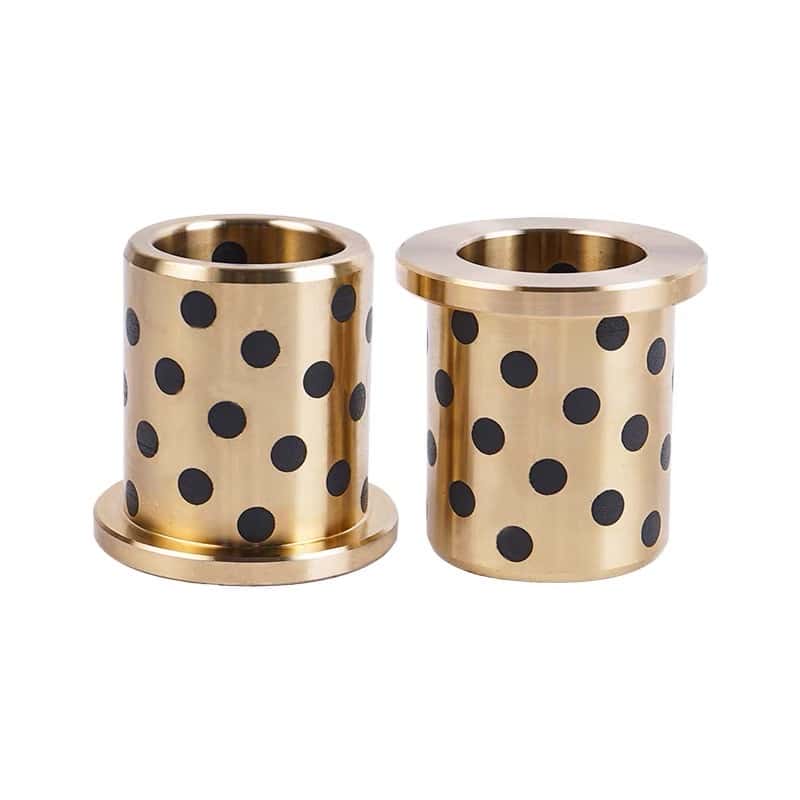
High-Quality Self-Lubricating Bearing Bushing Materials
Learn more about the variety of graphite bushing materials offered by bronelube.com
graphite is a superior lubricant that does not require additional lubrication. Its self-lubricating properties make it an ideal material for use in a wide range of industrial applications. Graphite reduces friction and wear between two surfaces, prolonging the life of the equipment and reducing maintenance costs. Additionally, it is environmentally friendly, making it an ideal choice for companies that prioritize sustainability. As a result, graphite continues to be a popular choice for businesses across a wide range of industries.
Cost saving, Graphite A Superior Lubricant Lowest Total Life Cycle Cost
Graphite is a naturally occurring mineral that has long been recognized for its superior lubricating properties. Its unique properties make it a highly effective lubricant, reducing friction and wear between two surfaces, even in high-temperature and high-pressure environments. Graphite’s superior lubricating properties make it a cost-effective solution in the long run. In fact, graphite has the lowest total life cycle cost of any lubricant on the market.
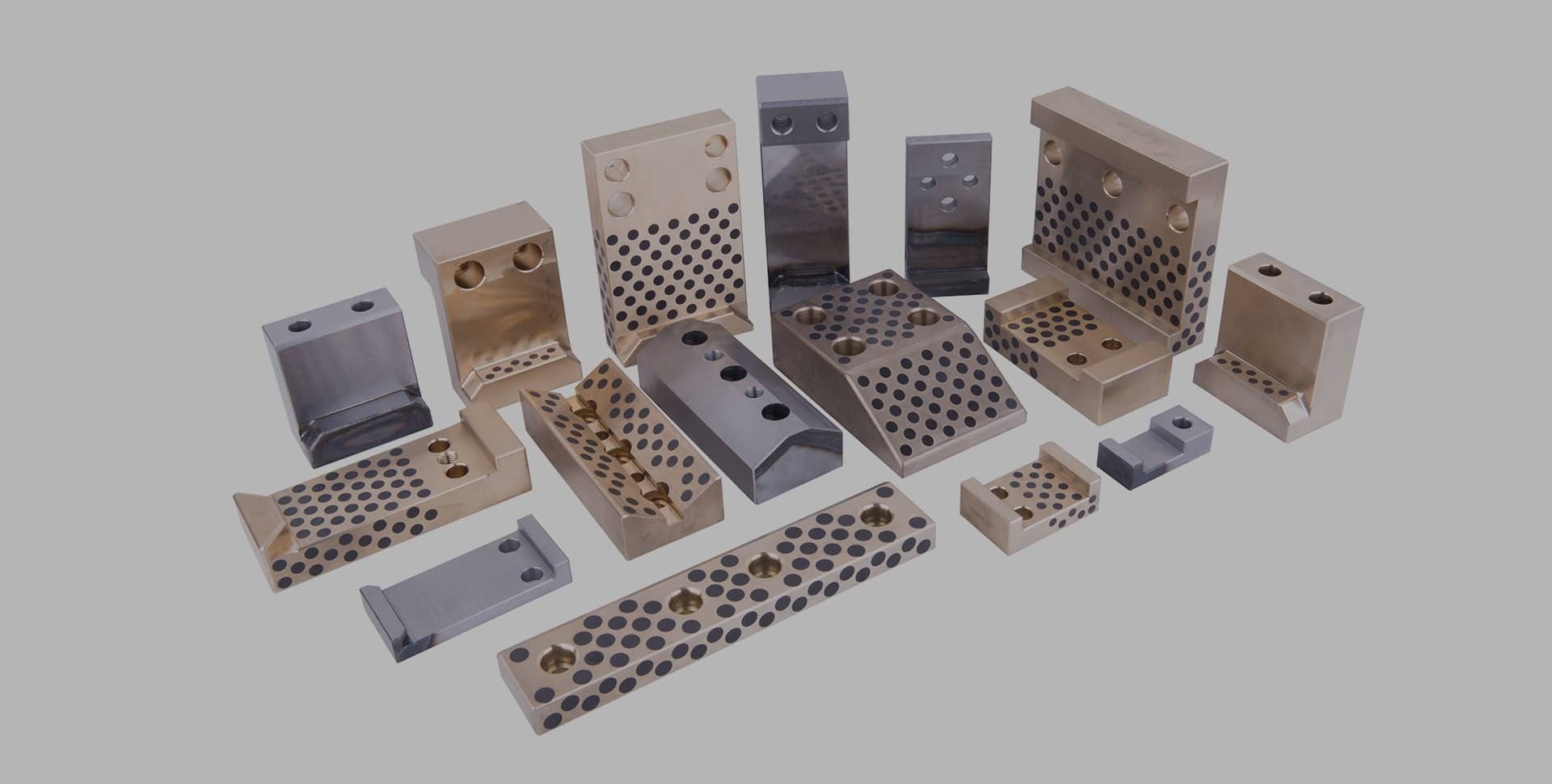
BUSHING DEAIGN
Custom Bearing Bushing We are happy to assist you!
Standard part numbers include wear plates, wear strips, bushings, gibs, and many other related items. bronzelube’s full product line, along with downloadable CAD models, can be viewed online at www.bronzelube.com. We support you in the design of your bearing bushing, from the selection of the right shape and the most suitable production process to the subsequent implementation and delivery. Please get in touch with us!
High Quality
Manufacturer of high-performance polymer-based bushing materials for a wide range of applications.
A Guide to Bearings and Bushings
Our experts are ready to help you find the right solution for your specific application.

Solutions For Every Industry
Searching for Dependable Bushing Solutions? viiplus Has What You Need.

Design Guides, Materials
Bushing design, Comprehensive design manuals covering a range of self-lubricating materials used in all of viiplus’s manufacturing processes.

Technical Guides
Manufacturing On Demand, Technical Guides For Machining Design. Discover the latest in metal alloys, materials, and design tips for manufacturing custom machined and self-lubricating bearing parts.

Get Instant Quote
To receive your instant quote, simply upload your drawing file and choose your production process & bushing material.

Prototyping, Place Order
After you place your order, we will start the production process. You will receive updates when your order has completed production and is ready to be dispatched.

Receive Your custom Parts
We provide precision-inspected high-quality parts, packing lists and documents, and delivery tracking.

